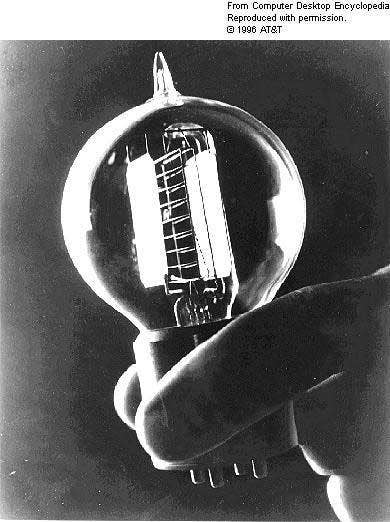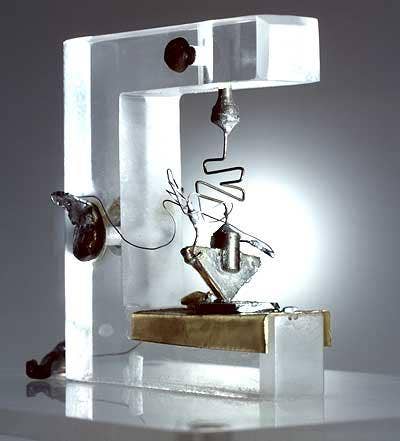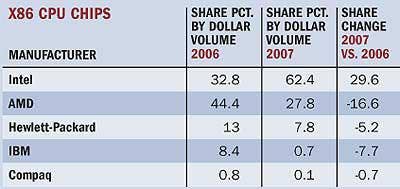Celebrating 60 Years Of The Transistor

Sunday marks the 60th anniversary of the assembly of the very first transistor, invented at Bell Labs in 1947. That legendary company, along with semiconductor manufacturers such as Texas Instruments, Fairchild Semiconductor, Intel and Advanced Micro Devices all contributed mightily to the massive surge in technological innovation that followed.

Before Bell Labs invented the transistor, electronic devices were made possible by vacuum tubes. An electron tube from which all or most of the gas has been removed, permitting electrons to move with low interaction with any remaining gas molecules, the vacuum tube has almost entirely been replaced by solid-state semiconductor devices such as transistors and solid-state diodes.

Invented at Bell Labs in 1947, this strange-looking device was called a 'point contact transistor' because amplification or transistor action occurred when two pointed metal contacts were pressed onto the surface of the semiconductor material. The contacts, which are supported by a wedge-shaped piece of insulating material, are placed extremely close together so that they are separated by only a few thousandths of an inch. The contacts are made of gold and the semiconductor is germanium. The semiconductor rests on a metal base.

In 1954, Texas Instruments was the first company to start commercial production of silicon transistors instead of using germanium. Silicon raised the power output while lowering operating temperatures, enabling the miniaturization of electronics. The first commercial transistor radio was also produced in 1954, powered by TI silicon transistors.

Jack Kilby invented the integrated circuit at Texas Instruments in 1958. Comprised of only a transistor and other components on a slice of germanium, Kilby's invention, 7/16-by-1/16-inches in size, revolutionized the electronics industry.

In 1961, Robert Noyce showed how two transistors could be made to work together on a single slice of silicon. This advance on earlier integrated circuits is the precursor of modern microprocessors that feature millions of transistors working together as integrated computational devices.

The original piece of graph paper upon which Gordon Moore drew up the basics of what became known as 'Moore's Law'. The most famous principle of computing has had various permutations over the years, but was originally stated by Moore in the April 19, 1965 issue of Electronics Magazine thusly:

The working heart of the first miniature calculator, invented at Texas Instruments in 1967, was an integrated semiconductor circuit array that contained all the necessary electronics for performing addition, subtraction, multiplication and division.

Intel co-founder Gordon Moore lecturing in 1970. Moore remains a giant of the semiconductor industry, both for his role in building the world's foremost microprocessor company and for his infrequent but influential public appearances to extend his eponymous 'Moore's Law' by another dozen or so years.

The Intel 4004, a 4-bit central processing unit (CPU) released in 1971 is purported to be the world's first complete microprocessor, though cases are also made for the the Texas Instruments TMS 1000 and Garrett AiResearch's Central Air Data Computer (CADC).

Intel released its 16-bit 8086 microprocessor in 1978, giving rise to what would become the most commercially successful CPU architecture in personal computing systems. In fact, x86 more accurately refers to binary compatibility with the 32-bit instruction set of the Intel 80386, first released in 1986, while Intel's follow-up to the 8086, the 8088, added the crucial feature of an external 8-bit data bus and was the processor used in the original IBM PC.

Advanced Micro Devices launched the mainstream multi-core processor era with the release of its dual-core Opteron chip in April, 2005. Boasting a 'native' multi-core micro-architecture, AMD's dual-core and quad-core processors incorporate memory controllers on the silicon die and feature independent power supplies to each core.

In late 2006, a team of researchers at Stanford and UCLA reported the development of a manufacturing process for 'flexible electronics' based on organic, or carbon-based, transistors. According to the researchers, an organic transistor array such as the one pictured here 'could enable technologies such as low-cost sensors on product packaging and "electronic paper" displays as thin and floppy as a placemat.'

An Intel manufacturing technician uses a scanner to start the very first 45nm production lot of 300mm wafers inside of Fab 32, Intel's high-volume 45nm chip factory in Chandler, Ariz. The first of Intel's Penryn family of microprocessors, built using the chipmaker's new Hafnium high-k metal gate process, were released in late 2007.

Processors on an Intel 45nm Hafnium-based high-k metal gate 'Penryn' wafer incorporate 410 million transistors for each dual-core chip, and 820 million for each quad core chip. The first of Intel's Penryn family of microprocessors were released in late 2007.